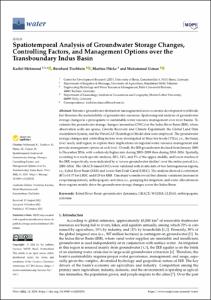Spatiotemporal Analysis of Groundwater Storage Changes, Controlling Factors, and Management Options over the Transboundary Indus Basin

Spatiotemporal Analysis of Groundwater Storage Changes, Controlling Factors, and Management Options over the Transboundary Indus Basin

| dc.contributor.author | Mehmood, Kashif | |
| dc.contributor.author | Tischbein, Bernhard | |
| dc.contributor.author | Flörke, Martina | |
| dc.contributor.author | Usman, Muhammad | |
| dc.date.accessioned | 2023-04-28T10:02:04Z | |
| dc.date.available | 2023-04-28T10:02:04Z | |
| dc.date.issued | 15.10.2022 | |
| dc.identifier.uri | https://hdl.handle.net/20.500.11811/10793 | |
| dc.description.abstract | Intensive groundwater abstraction has augmented socio-economic development worldwide but threatens the sustainability of groundwater resources. Spatiotemporal analysis of groundwater storage changes is a prerequisite to sustainable water resource management over river basins. To estimate the groundwater storage changes/anomalies (GWCs) in the Indus River Basin (IRB), where observation wells are sparse, Gravity Recovery and Climate Experiment, the Global Land Data Assimilation System, and the WaterGAP Hydrological Model data were employed. The groundwater storage changes and controlling factors were investigated at three tier levels (TTLs), i.e., the basin, river reach, and region, to explore their implications on regional water resource management and provide management options at each level. Overall, the IRB groundwater declined from January 2003 to December 2016, with a relatively higher rate during 2003–2009 than during 2010–2016. Spatially, according to a reach-specific analysis, 24%, 14%, and 2% of the upper, middle, and lower reaches of the IRB, respectively, were indicated by a ‘severe groundwater decline’ over the entire period (i.e., 2003–2016). The GRACE-based GWCs were validated with in situ data of two heterogeneous regions, i.e., Kabul River Basin (KRB) and Lower Bari Doab Canal (LBDC). The analysis showed a correlation (R2) of 0.77 for LBDC and 0.29 for KRB. This study’s results reveal that climatic variations (increase in evapotranspiration); anthropogenic activities, i.e., pumping for irrigation; and water allocations in these regions mainly drive the groundwater storage changes across the Indus Basin. | en |
| dc.format.extent | 20 | |
| dc.language.iso | eng | |
| dc.rights | Namensnennung 4.0 International | |
| dc.rights.uri | http://creativecommons.org/licenses/by/4.0/ | |
| dc.subject | Kabul River Basin | |
| dc.subject | groundwater dynamics | |
| dc.subject | GRACE | |
| dc.subject | WGHM | |
| dc.subject | GLDAS | |
| dc.subject | anthropogenic activities | |
| dc.subject.ddc | 333.7 Natürliche Ressourcen, Energie und Umwelt | |
| dc.title | Spatiotemporal Analysis of Groundwater Storage Changes, Controlling Factors, and Management Options over the Transboundary Indus Basin | |
| dc.type | Wissenschaftlicher Artikel | |
| dc.publisher.name | MDPI | |
| dc.rights.accessRights | openAccess | |
| dcterms.bibliographicCitation.volume | 2022, vol. 14 | |
| dcterms.bibliographicCitation.issue | iss. 20 | |
| dcterms.bibliographicCitation.pagestart | 1 | |
| dcterms.bibliographicCitation.pageend | 20 | |
| dc.relation.doi | https://doi.org/10.3390/w14203254 | |
| dcterms.bibliographicCitation.journaltitle | Water | |
| ulbbn.pubtype | Zweitveröffentlichung | |
| dc.version | publishedVersion | |
| ulbbn.sponsorship.oaUnifund | OA-Förderung Universität Bonn |
Dateien zu dieser Ressource
Das Dokument erscheint in:
-
Publikationen (29)




